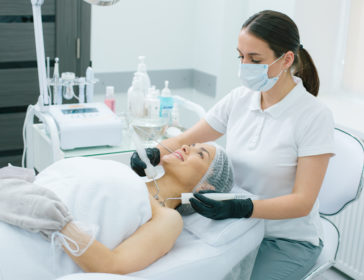
Health
- HONG KONG
How To Find Private Health Insurance In Hong Kong?
Your Guide To Private Healthcare

Are you new to Hong Kong and looking for a health insurance provider? Or have you been using the city’s public healthcare system and are now looking to make a switch? Little Steps deep dives into the ins and outs of health insurance in Hong Kong – deciphering the differences between the private and public sectors, explaining the medical jargon, and recommending the city’s best family insurance providers.
-

PRIVATE VS PUBLIC HEALTHCARE IN HONG KONG
What Are The Main Differences Between Private And Public Healthcare?Hong Kong is blessed with a robust public healthcare system that rivals most countries around the world. If you hold a valid Hong Kong Identity Card (HKID), regardless of whether you are a Hong Kong citizen, you can receive care in the public system. Doctors are first-rate. The city’s 43 public hospitals are clean and equipped with modern technology. Most importantly, costs are heavily subsidized by the Hong Kong Government, requiring patients to pay very little out of pocket.
That said, there are several reasons why some families opt for private health insurance instead. Firstly, public hospitals are crowded and waiting times for appointments can be anywhere from an hour to the better part of a day. Secondly, people can wait for months, if not years, for non-urgent surgical procedures. And lastly, if you’re after a good bedside manner, you may not find it in the public system. Doctors and nurses work long hours and have little time for each patient, often resulting in what may feel like hurried consultations.
In summary, while Hong Kong’s public healthcare system is first-class, the aforementioned reasons push some people into the private sector. And due to the high costs of private healthcare, purchasing the right type of health insurance for you and your family is extremely important.
-

MEDICAL TERMINOLOGY 101
Deciphering The Jargon Within A Health Insurance PolicyBefore you commit to costly, private health insurance, it’s good to educate yourself on the jargon. Below are a few keywords and phrases that commonly appear in an insurance plan.
- Premium: This is the amount you pay for your health insurance every year. Some insurance companies will allow you to split the fee into monthly or bi-annual payments, but usually, it is most cost-efficient to pay the full sum annually.
- Deductible: If you opt to have a deductible, this is the amount you will need to pay for covered health care services before your insurance plan kicks in to cover the rest. For example, let's say you have a HK$15,000 deductible for inpatient services. If you are hospitalized, you will need to pay the first HK$15,000 of your bill out of pocket. Insurance plans with higher deductibles often have lower premiums.
- Copay: If you opt for a copay, this is a predetermined rate that you pay for each medical service enlisted. For example, if you have a 20% copay, you will pay the first 20% of any medical bill, and your insurance will cover the remaining 80%. Insurance plans with higher copays often have lower premiums.
- Inpatient Care: This is when a patient receives services or treatment whilst staying in the hospital. For example, a patient who requires surgery in a hospital and then spends a week recovering. Most insurance plans in Hong Kong cover inpatient services as part of the basic plan.
- Outpatient Care: This is when a patient receives services or treatment in a clinic or hospital without an overnight stay. For example, if you have a cold and visit the doctor, this is considered outpatient care. Most insurance plans in Hong Kong charge extra for outpatient care.
- Pre-existing Conditions: A medical illness or injury that you have before starting a new health insurance plan will likely be considered a pre-existing condition, such as diabetes, arthritis, or asthma. Insurance companies can deny coverage due to these or will likely charge you a higher premium if you have a chronic condition.
-

IDENTIFYING YOUR FAMILY'S HEALTH NEEDS
What Health Needs Are Unique To You And Your Family?Now you’re armed with an understanding of all the terms listed above. We can dive into what they mean when you’re comparing health insurance plans for your family.
The premium, or cost of the plan, will likely be one of the first things you consider. It’s fairly logical that plans with higher premiums tend to cover more. Still, you may look through the list of inclusions and decide that you don’t need things like dental, physiotherapy, homeopathy, and optical services, and therefore opt for a plan with a lower premium and fewer inclusions.
You can play with the numbers when it comes to deductibles and copays to see if they're worth it to pay a lower premium. For example, if a plan has the option of a HK$20,000 premium for hospitalization or a HK$12,000 premium with a HK$16,000 deductible, you may decide it's worth the risk and opt for the lower premium. If you get through the year without requiring hospitalization, then you come out on top, having saved HK$8,000 (the difference between HK$20,000 and HK$12,000). However, if you do require hospitalization, then you may lose out as you could end up paying HK$28,000 (HK$12,000 plus the HK$16,000 deductible).
It’s also important to consider whether you want inpatient care (standard with most plans) or outpatient care as well, which can double your premium in some cases. Families with young children who are often sick will likely see the benefits of outpatient care. However, families with older kids or adults may see that their outpatient costs don’t amount to much each year and decide that it’s not worth the extra cost.
Geographical coverage is another thing you should consider, as the cost of medical insurance plans will often vary depending on which areas are covered. If you live in Hong Kong and rarely travel, something that covers Asia should only be sufficient. If you are an expatriate living in Hong Kong and frequently travel home each year, then perhaps consider a plan that has worldwide coverage.
And lastly, it’s always important to read the fine print. Some plans will have a cap on hospitalization, outpatient consultations, and medicines, whereas others will have unlimited coverage.
-

MEDICAL INSURANCE FOR PREGNANT WOMEN
What Do You Need To Know If You're Expecting?Hong Kong’s public healthcare system offers exceptional services to expecting mothers. However, if you do opt for a private birth, maternity insurance will make a huge difference as the costs can be truly eye-watering. Expect to pay anywhere from HK$100,000 to HK$250,000+ depending on the hospital, room type, obstetrician, and type of birth you choose. Maternity insurance is often an additional cost on top of your regular insurance plan and can cover three main areas:
- Prenatal Care: This includes things that happen prior to giving birth. Think ultrasounds, blood tests, consultations with your obstetrician, and even educational classes such as breathing and first aid.
- Birth: This includes the entire birthing process, from the hospital you choose, the room type within the hospital (standard, semi-private or private), the obstetrician, anesthetist, pediatrician, the type of birth (normal delivery, cesarean section, or emergency c-section), and any complications that arise during birth to both mother and baby.
- Postnatal Care: This can include services such as newborn care, check-ups, vaccinations, and more.
One of the most important things to consider when purchasing maternity insurance is that most plans have a waiting period of anywhere from 9 to 18 months (12 months being the norm). This means that you will need to wait 12 months from the date of purchasing your plan to get pregnant – if you conceive before 12 months, you will not be entitled to any of the benefits.
-

-

TOP HEALTH INSURANCE PROVIDERS IN HONG KONG
Guide To The Best Medical Insurance Providers In Hong KongThere are dozens of health insurance providers in Hong Kong, but we’ve handpicked a few of our favorites:
- Bupa Global: Bupa’s Global Elite Health Plan has a very comprehensive cover for families with free coverage for up to two children under 10. This is unique in the market and has been very well received by their clients around the world. All members covered under Bupa Global’s international health plans also enjoy direct access to a specialist's choice without a GP’s referral (such as hassle at times!), which ensures clients receive treatments without delay. Bupa’s customer service is also second-to-none with not only knowledgeable but thoughtful staff, who listen to your needs and suggest accordingly, rather than simply trying to flog the most expensive plan. Email Internationalsales@bupa.com for more information.
- Pacific Prime Hong Kong: Because no two families are the same, Pacific Prime offers plans customized to each family. They are an insurance broker with excellent relationships with worldwide insurers. They will sit down with you to understand your family's needs and then negotiate the best possible plan on your behalf. Call +852 3113 1331 for more information.
- Cigna: Cigna has a new Health4Kids Premium Refundable Plan that includes major disease coverage, preventative care for kids, and hospital cash. It also gives parents the chance to accumulate wealth for their children, enjoying up to 118% cash value of the Basic Premium paid upon maturity. Call +852 8206 2218 for more information.
Want More?
Little Steps Asia knows what families need.
Sign up for our email newsletters to get the most out of Asia!
-
Hong Kong
Celebrate Mother’s Day 2025 Aboard The Aqualuna Hong Kong
Dim Sum, Afternoon Tea, Champagne & Flower Planting Workshop2025 May 10 - 2025 May 11 -
Hong Kong
Liverpool vs AC Milan, Arsenal vs Spurs In Hong Kong: When And How to Get Your Tickets
Watch Premier League Play Live At The Hong Kong Football Festival 2025! -
Hong Kong
Explore Pacific Place’s LEGO® Botanical Garden: Where Bricks Bloom
Stunning LEGO® Displays!2025 Apr 24 - 2025 May 18 -
Hong Kong
Stitch Takes Over Harbour City Hong Kong!
Fun Movie Installations, Workshops, Pop-Up Shop & More!2025 May 01 - 2025 Jun 15 -
Hong Kong
Shop & Support A Good Cause At The Mums@PLAY Mother’s Day Market 2025
A Special Mother's Day Marketplace In Partnership With The Hive, Little Steps Asia, Foundation for Shared Impact (FSI) & Others2025 May 04 - 2025 May 04 -
Hong Kong
Best Family-Friendly Events In Hong Kong – April 2025
Read On For Events Not To Miss In April For Kids And Families In Hong Kong2025 Apr 01 - 2025 Apr 30 -
Hong Kong
Events & Things To Do On Mother’s Day In Hong Kong 2025
Things To Do On Mother's Day In Hong Kong -
Hong Kong
Your Family-Friendly Guide To Affordable Art Fair Hong Kong 2025
Art For The Whole Family & Guided Tours & Workshops For The Kids!2025 May 22 - 2025 May 25 -
Hong Kong
Hong Kong’s Cinema Day Returns On May 10, 2025
Book Your Movie Tickets For HK$30 Starting May 6, 20252025 May 10 - 2025 May 10 -
Hong Kong
Casetify x Takashi Murakami Pop-Up Lands At LANDMARK
iPhone Cases, Luggage & Other Mr DOB Accessories & Products2025 Apr 12 -
SIGN UP
Hong Kong Tips, Deals + Events.
Got kids? Little Steps Asia gives you the scoop on all the things to do and see with babies, toddlers, and kids in Hong Kong, Singapore, Kuala Lumpur, Bali, Jakarta, Macau, and beyond. From family-friendly hotels, kids and baby shops, the best schools and after school activities, pregnancy tips and meet-ups and more – we have you sorted.
Sign up to receive the free Little Steps email newsletter packed with news, offers, and hidden treasures for Hong Kong families.
© 2025 Little Steps Asia. All rights reserved.

















